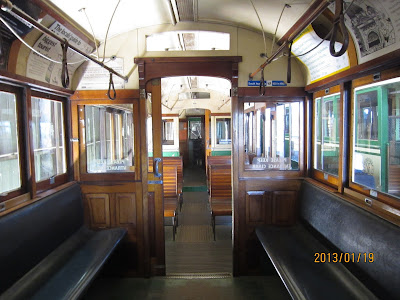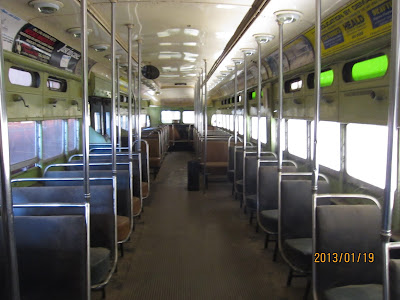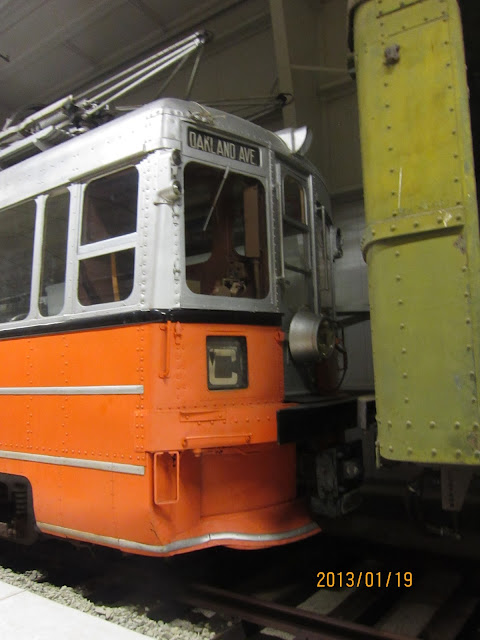Hello, good people of the Earth!
I do realize that it has been a while since my last post, but schooling and other personal matters
have forced me to neglect my blog for a couple of months. So, in that case, let's get started!
So, on April 24 we took a trip out to a trolley museum in Suisun-Fairfield, CA, to ride on their Scenic Limited train service. We had not gone to the museum in almost two years, so it was good getting to see all the trolleys, trams, streetcars, and any other synonym for "light rail." On our way there, along the highway, the Dublin/Pleasanton Line runs down the center of the freeway, between Castro Valley Station and Dublin/Pleasanton, and BART trains bound for Millbrae, Pittsburg-Bay Point, and Dublin/Pleasanton appear about once per ten minutes. However, today marked the first time that we had actually paced a BART train doing about 65-70 mph. So, this is a sort-of-pan photo of Rohr A-Cab 1253 along the highway bound for Dublin/Pleasanton.

Sometimes, though, it beat us, and we beat it. I guess even the computer controlling the train could not keep it at a steady speed. Or, of course, we could be the ones with a fluctuating speed. But that would never happen, now would it?
I even took a video for you! You'll see that towards the end, we pulled ahead and eventually came off of the highway. The reason for the decrease in speed was that the station prior to Dublin/Pleasanton had come up, so the train was slowing down. Incidentally we had to pull off of the highway, so, no harm done.
At the WRM, they offer two rides. Both are included in the admission price. These rides are the trolley, which lasts 15 minutes and just travels in a loop, and then the interurban, which runs for an hour and uses the Petaluma, Santa Rosa, and something else that I don't remember. The last two times that we have visited this museum, we have received Oakland Traction Company 352 on the trolley ride. This trolley is a trolley that, in my opinion, is one of their better-kept trolleys. For one, the paint scheme is a nice hue of blue and beige, and also, it retains much of it's original features, such as the advertisements on the inside and the rollsigns.
When we were talking to a docent, he told us a story about the bogies when they were restoring it. Supposedly, they had restored all the components of the trolley...except for the bogies. They searched far and wide, from eBay to Amazon, yet they still could not find it. Then one day, one of the volunteers noticed that this design of tram, from about 1936, could be found in Japan. So they bought two of the bogies, and they finally were able to bring this little trolley back to life.

This is a video of the Scenic Limited, otherwise known as the Main Reason of our Visit, passing the trolley that we were riding on.
This is the first class car 751 from the Utah interurbans. In first class, you apparently get cookies and AC, for an extra $17. Thanks, but no thanks. I'll take the economy class.

This is Car 1 on the train, which we rode in. Because it operated on the Bay Bridge, a bridge in San Francisco that is now ruled by the cars, it was equipped with contact shoes, for BB operation, a pantograph for operation elsewhere, a pole for city streets, and two different voltage capabilities! 

This little...thing...is an inspection car, most likely. Or just an advanced form of North Korean rail transport.
This predecessor PCC trolley was operated by MUNI in the early days. It is the last remaining Magic Carpet PCCs, and no, I don't know why they were called that. Maybe because they were the "quiet" trolley as opposed to the older trolleys with air-compressors.

Strangely, the W-Class trams were all divided into three sections: closed, semi-open, and then closed again.
Moving on, this is Boeing-Vertol Light Rail Vehicle. MUNI, alas, did not like them, and they were subsequently dumped. I have heard rumors that this LRV is actually operational, but officially, the answer is that it cannot run on its own power.
This is the trolley that I really wanted to see. This is a Sacramento Northern Birney Safety Streetcar that only has one bogie. It is adorable! It has extra long windows, and, well, I just like it.
This is a Blackpool boat tram. Muni currently owns two, and the Blackpool tramway company retains some of these cars in their "C" stok heritage fleet that only comes out on weekends. Because the Blackpool tramway operates gigantic double-decker tramcars, all single-levels are equipped with a tower that houses either the pole or the pantograph.

This is the front of a real PCC car. Not much else to say...it's a PCC.
OK, OK, I did have something else. Did you know that PCC stands for President's Commerce Committee?
This is an interior familiar to any person that has ridden the MUNI F-Line or E-Line.
This was my first time seeing a GE 70-ton switcher locomotive. I was ecstatic. This 70-tonner operated on the CCT, or Central California Traction Company, which had operated some ex-SN Birneys.
This is a CN speeder outside of Carbarn 3, which we eventually went into, after the ride on the Scenic Limited.
This is a derelict old Kennecott Copper Corp. locomotive that was sitting at Carhouse 2, which the public is not allowed into.
This is a head-on view of the GE 70-tonner.
The last time we visited, this Key System Bridge Unit was in Carhouse 3, still waiting for restoration. Now it's in Carbarn 1...still awaiting restoration.

Well, since the train had just come in and they seemed to require 10 extra minutes before letting us board, that allowed us to take pictures of the trains on track 3, in Carbarn 1. This is a MUNI streetcar set to run on the L Taraval line. I've ridden the L Taraval before, and it travels between the SF Zoo and Embarcadero station.
This is Salt Lake, Garfield, and Western interurban. Most likely, I'm guessing, it was built by Brill. 

OK, the ride has started! About halfway through we passed through this field where the farmer had left a bunch of cows out. Now, in this area, it can get hot and windy, and that day was both. So...the cows all clumped around the tree. I believe that I got to see one take a dump. Fun!

The cab of the interurban is wide and very spacious. We had taken a spot that was near the cab in hopes of a railfan window. No such luck. Hey, at least I got to see the cab!

This is the Kennecott Copper locomotive. Kennecott liked their locomotives to be very, very large. This locomotive was stationed outside of the Carbarn 2, which is closed to the public.

This is a Sacramento Northern caboose car that was on display in Carbarn 3, which is only open for guided tours. They generally have one at around maybe 3:40, because that is around the time that the interurban returns.
This is a baggage car that was behind a steam engine.
The reason for this steam engine was because it was supposed to represent the competition. In the background, there is also a GE 44-tonner, but the guide did not exactly tell us much about that.

Supposedly, this is a BART test car on the test track which parallels the former Sacramento Northern mainline. Personally, I find this picture a little hard to believe, as the window seems to be a little short, but, hey, anything's possible.

This is our guide with another Kennecott copper locomotive. I'm telling you, those things are taaaaaaaall!
This was the original interurban that I rode. It is a Key System Bridge Unit, and it is painted in the orange-black-grey paint scheme.
These are the Richmond Military Railway's two army transporters. Supposedly, legend says that because the army has an odd obsession with either grey or green, they originally painted these ex-Manhattan el train cars grey all over, during WWII. However, because of blackout rules, cars could not see these trains when they came around a bend or something. So, to fix this, they had the trains painted with yellow stripes.
This is actually a Siemens-Duewag U2 tram from San Diego. I actually rode one of these before, in January 2015, when we took a trip down there.

As you can see, its destination blind is saying that it is on a Blue Line routing, bound for the border. As far as I know, Edmonton, some of San Diego, and Germany are still operating these trams.
This is an ex-SN electric locomotive, and it was most likely used to haul freight up the gradients where the SN used to run. (Chico, Sacramento, SF)

Inside the museum, they had a display of wind power and stuff like that. So there was also a model, where you could drive a model PCC around, but only if you cranked it hard enough.
And that was it for the museum.
Well, aside from their bookstore. I bought a book on PCC streetcars, it was very good, and The Pictorial History of Electric Locomotives. Both are recommended.
This is a rather well-hidden cell phone tower that was off of a highway entrance ramp near Newark, CA.
Well, that's all for this time. Tune in next time to hear something about my 2015 Japan-Taiwan trip or April NYC trip.
Thanks for reading!

































No comments:
Post a Comment